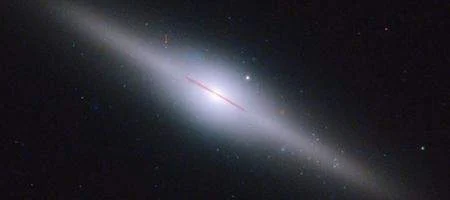Astronomers have identified the first known ‘middleweight’ black hole, after spotting outbursts of super-hot gas with CSIRO’s Australia Telescope Compact Array.

Called HLX-1 – for hyper-luminous X-ray source 1 – it lies 300 million light-years away in a galaxy called ESO 243-49. Its discovery fills a long-standing gap: until now, astronomers have had good evidence only for supermassive black holes, up to a billion times the mass of the sun, and stellar mass ones, three to thirty times the mass of the sun.
However, it’s thought that supermassive black holes may be formed by the merging of intermediate ones such as this.
“This is the first object that we’re really sure is an intermediate-mass black hole,” says Dr Sean Farrell of the University of Sydney.
HLX-1 was discovered by chance in 2009, because it stood out as a very bright X-ray source: X-rays are released as gas from a star or gas cloud is sucked into a black hole and heated to extreme temperatures.
“A number of other bright X-ray sources have been put forward as possibly being middleweight black holes. But all of those sources could be explained as resulting from lower mass black holes,” says Dr Sean Farrell of the University of Sydney.
“Only this one can’t. It is ten times brighter than any of those other candidates. We are sure this is an intermediate-mass black hole – the very first.”
Dr Farrell speculates that a companion star traverses a very eccentric orbit around the black hole. When the companion comes close, the black hole strips gas from its partner, giving rise to the X-ray flaring.
The brightness of the X-ray and radio flares have allowed the team to put an upper limit on the mass of the black hole of 90,000 times the mass of the Sun. However, Dr Farrell says that this is a conservative estimate, and for a variety of reasons a lower figure of around 20,000 solar masses is more likely.
So why haven’t more intermediate-mass black holes been found?
“There maybe lots of others out there that are not currently feeding, and so are not detectable, or are feeding at a very low rate, so they don’t stand out as intermediate-mass black holes,” says CSIRO’s Dr Ron Ekers.
HLX-1 may have been the central black hole of a low-mass dwarf galaxy that was swallowed by the larger galaxy ESO 243-49 – just as our own Milky Way galaxy has swallowed up others.
There’s evidence of star formation around HLX-1, which would be consistent with such a ‘plunging dwarf’. The team’s now looking for other signs of disturbance around the black hole, such as gas streams, which would also support this idea.






